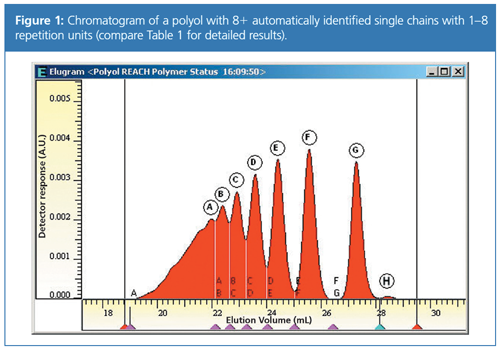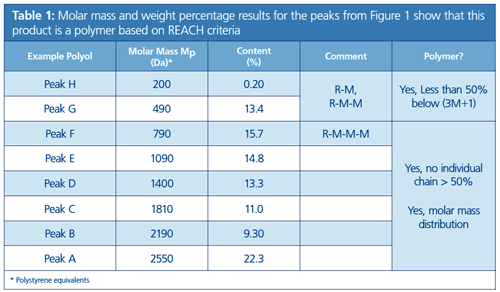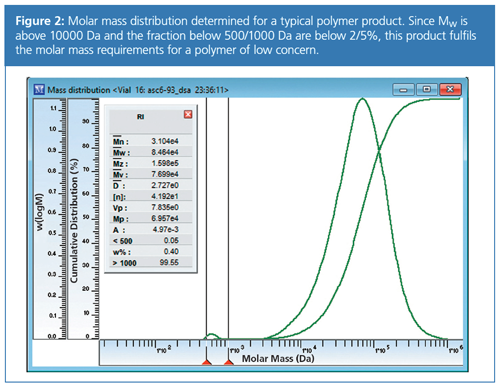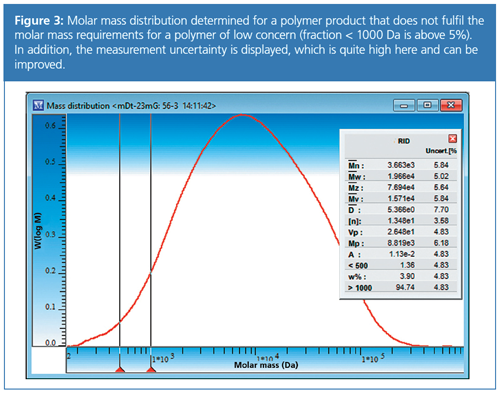Tips & Tricks GPC/SEC: Product Registration and REACH
Molecular mass is one of the central parameters required for product registration. Compared to low molar mass substances, the molar mass determination of macromolecular products is more difficult because the product is a mixture of chains with different lengths and, therefore, molar masses. Gel permeation chromatography/size-exclusion chromatography (GPC/SEC) is the standard technique to separate macromolecules by size and to measure the complete molar mass distribution as well as the molar mass averages. This technique therefore provides crucial information for product registration, including REACH.
Daniela Held, PSS Polymer Standards Service GmbH, Mainz, Germany
Molecular mass is one of the central parameters required for product registration. Compared to low molar mass substances, the molar mass determination of macromolecular products is more difficult because the product is a mixture of chains with different lengths and, therefore, molar masses. Gel permeation chromatography/size-exclusion chromatography (GPC/SEC) is the standard technique to separate macromolecules by size and to measure the complete molar mass distribution as well as the molar mass averages. This technique therefore provides crucial information for product registration, including REACH.
(High) performance polymers comprise widely varying molecular weights, structures, and compositions. These molecular parameters influence the macroscopic properties of the resulting product and are adjusted during the development process.
A big advantage of polymers and macromolecules is that they can be considered as non-toxic, even when produced from toxic monomers. As a result of their size and the fact that reactive functional groups are reacting during polymerization, polymers are usually considered to be (bio)chemically inert and do not pose a threat to humans and the environment. Of concern, however, are unreacted monomers, oligomers, and adjuvants and additives, which are added to improve the processability, the stability, and the quality of the final product. Leaching of these (potentially toxic) components can cause severe (health) issues. Registration agencies therefore require comprehensive characterization with detailed molar mass information and, for some products, also extractables and leachables studies.
The molar mass of a product is traditionally measured using gel permeation chromatography/size-exclusion chromatography (GPC/SEC) and the results are of the utmost importance because the molar mass can influence which registration category will apply for a new product, for example, the molar mass determines whether new products fall into the category “polymer of low concern” (PLC) or if a product is subject for registration or not (EU REACH). Accordingly, the generation of detailed and appropriate molar mass data that satisfies regulatory guidelines is a key component of successful registration.
REACH
REACH, Registration, Evaluation, Authorisation, and Restriction of Chemicals, is an EU regulation that came into force on 1 June 2007. It addresses the production of chemicals and their impacts on human health and the environment. For Europe, all polymers are exempt from registration and evaluation under REACH. A polymer is here defined using three criteria:
- The molecules must be distributed over a molecular weight range.
- The weight percentage of molecules containing three monomer units or above should exceed 50% (3M+1 rule).
- The weight percentage of any molecule of the same molecular weight shall not exceed 50%.
Different REACH-like regulations around the world have adopted this definition, although the regularity requirements about the consequences may differ. For example, polymers are not exempt for China-REACH.
The preferred method to determine whether a substance falls under the definition of a polymer is GPC/SEC with referral to OECD TG 118 (1).
If the molar mass of a product is sufficiently low, GPC/SEC separations often show a nice oligomeric profile as shown in the chromatogram in Figure 1. Identification of the single peaks is possible by overlaying the data with at least one known reference material. The single peaks can then be evaluated with respect to molar mass and weight percentage. The example shows a polyol with a molar mass distribution (criteria 1 met) and eight automatically identified peaks for chains with 1–8+ repetition units. For higher molar masses (longer chains, 8+ repetition units), the resolution of GPC/SEC was not sufficient to resolve this into single peaks. This behaviour is very typical for GPC/SEC where for higher molar masses broader peaks are observed.

Table 1 shows the numerical results for the eight identified species and a comparison with REACH polymer definition criteria. By comparing the REACH criteria with the GPC/SEC results, it is seen that all three REACH criteria are met. Consequently, the substance is a polymer according to the definition of REACH.

Polymers of Low Concern
Product registrations often require the Mw (weight average molecular weight) and the mass fractions below a defined molar mass, such as 500 or 1000 Da. This is required to classify a product as a PLC. Unfortunately, the definitions for PLCs in different countries can vary as well as the required actions-nevertheless GPC/SEC is able to provide the required information.
In addition to the area percentage values for each well separated peak, GPC/SEC results include the molar mass distribution, which allows Mw to be determined and the required fractions deduced. The molar mass distribution is obtained from the chromatogram when a calibration curve is available (or more precisely, when the molar mass information for each elution volume is available) (2). As a result of the special transformations required in GPC/SEC analysis it is important to ensure that the results for registration are taken from a true molar mass distribution and not from a chromatogram where only the elution volume is replaced by the molar mass (3).
Figure 2 shows an example for a sample with a broad molar mass distribution (no resolution into single peaks) with graphical molar mass distribution and molar mass averages as well as the fractions below 500 Da and above 1000 Da. According to the definitions in the US and China, this sample is a polymer of low concern because the Mw is above 10,000 Da, less than 2% are below 500 Da, and less than 5% are below 1000 Da. For a polymer of Mw between 1000 Da and 10,000 Da, the fractions below 500 Da should be below 10% and below 1000 Da 25%, respectively.

Please note that there are some general exclusions for polymers, which are generally not exempted. Cationic or potentially cationic polymers, highâmolecular-weight water absorbing polymers, and polymers that degrade, decompose, or depolymerize are not eligible for exemption. Reactive groups can also be a problem; as a consequence, a polymer would not be exempted from regulations, even if the mass results indicate that it is a polymer of low concern.
In addition, the mass fraction for every molar mass slice (sometimes referred to as slice list) can be required for product registration. An additional slice list can easily be created once the molar mass distribution is available. From this slice list the required parameters discussed above can be directly determined.
Measurement Uncertainty and Influence of Analytical Parameters
Analytical scientists producing data for product registrations should reflect on at least two important parts of GPC/SEC analysis.
First, all analysts must make the right choice for calibration. GPC/SEC, as a relative method, always requires a calibration, either using reference materials or an additional detector that allows the molar mass to be measured directly (4). In case of registrations, where the low molar mass parts are of highest concern, mass spectrometry (such as electrospray ionization mass spectrometry [ESI-MS] or matrix-assisted laser desorption–ionization [MALDI]) can be a valuable addition for products where no chemically matching reference materials are available (5). If chemically matching reference materials are available, it is recommended to select these materials over more common materials.
Partially related to calibration, the measurement uncertainty is the second part to be reviewed (6). Quality of raw data, analytical conditions, and calibration quality influence the results, and the measurement uncertainty can help to identify random error sources to improve the quality of the data.
Figure 3 shows an example of a molar mass distribution where the fraction below 1000 Da is slightly above the 5%. Here data review is particularly important because the results lie close to the boundary for a PLC classification. A more detailed analysis showed that both calibration quality (here: not enough data points in the low molar mass area) and the quality of raw data (here: detector noise) were the main sources of uncertainty and should be improved to gain more confidence in the data. This is particularly true in such critical cases where it is important to have a sound, well developed, and documented method, in addition to the support of additional methods and data to enable the company to make the right decisions and to produce trustworthy, precise, and accurate data.

Summary
• The molar mass of a product determines which registration category will apply. GPC/SEC data are therefore crucial for product registrations.
• Molar mass averages are often not sufficient. Detailed analysis is required, especially in the low molar mass area (toxicity).
• Registration data can only be obtained from true molar mass distributions where the y-axis w (log M) is correctly converted. Results for fractions could otherwise be wrong.
• Determination of result uncertainty can be important to ensure that the submitted results are of high analytical quality.
References
- OECD Guidelines for the Testing of Chemicals, Section 1, Physical-Chemical properties Test No. 118: Determination of the Number-Average Molecular Weight and the Molecular Weight Distribution of Polymers using Gel Permeation Chromatography
- P. Kilz and D. Held, The Column 10(22), 26–30 (2014).
- P. Kilz and D. Held, in Quantification in LC and GC, S. Kromidas and J. Kuss, Eds. (Wiley, 2009).
- D. Held, The Column4(6), 18–21 (2008).
- D. Held, The Column7(6), 11–14 (2011).
- D. Held and P. Kilz, The Column8(10), 14–20 (2012).
Daniela Held studied polymer chemistry in Mainz, Germany, and works in the PSS software and instrument department. She is also responsible for education and customer training.
E-mail:DHeld@pss-polymer.comWebsite:www.pss-polymer.com

Polysorbate Quantification and Degradation Analysis via LC and Charged Aerosol Detection
April 9th 2025Scientists from ThermoFisher Scientific published a review article in the Journal of Chromatography A that provided an overview of HPLC analysis using charged aerosol detection can help with polysorbate quantification.
Analyzing Vitamin K1 Levels in Vegetables Eaten by Warfarin Patients Using HPLC UV–vis
April 9th 2025Research conducted by the Universitas Padjadjaran (Sumedang, Indonesia) focused on the measurement of vitamin K1 in various vegetables (specifically lettuce, cabbage, napa cabbage, and spinach) that were ingested by patients using warfarin. High performance liquid chromatography (HPLC) equipped with an ultraviolet detector set at 245 nm was used as the analytical technique.














